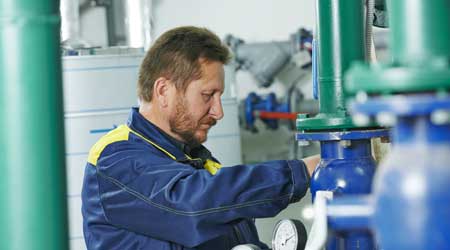Boiler and Water Heaters: No Cookie Cutter Solutions for Improved Efficiency
Part 3 of a three-part article on HVAC savings
In order to be successful, efforts to improve the overall energy efficiency of boilers and water heaters in any given facility must take into account the existing processes and equipment in that facility. In other words, there are no cookie-cutter solutions.
Consider this example: A facility operates a large boiler year round to provide steam to two instantaneous heaters, which keep the potable water outlet temperature at 130 degrees.
A new, high-efficiency, condensing, gas-fired boiler could perform this task, which would allow operators to cycle down the large steam boilers in the non-heating season. The instantaneous potable water heaters would remain for emergency backup and could be started by the BAS if a condensing boiler fails. This set-up provides a backup in the unlikely loss of natural gas, where the large, dual-fuel boilers could be started in oil-fired mode to support the instantaneous steam potable water heaters.
The boiler efficiency for the condensing boiler is 98 percent, so it would pay for itself quickly in the energy losses of the dual-fuel, main steam boilers and the losses inherent in the instantaneous heaters.
In addition to using the condensing boiler for heating potable water, managers can include these energy-saving BAS controls for potable water heating:
• �provide BACnet integration to the new condensing boiler, which would allow extensive monitoring, alarming, trending and control features for the boiler
• �provide a BTU meter for the potable water loop to allow the BAS to monitor the rate of energy use for water heating and calculate the energy rate for daily, monthly, and yearly use
• �provide BAS start and stop points for the operation of recirculation pumps on the potable water loops, which also would include status monitoring of the pumps in case of failure
• �scheduling the recirculation pump for a reduction of energy and thermal losses from the pump loops when the facility is unoccupied.
Compiling and presenting key data is essential to secure buy-in for an energy efficiency plan and should include:
• �total budget cost figures from each of the team members to accomplish the project
• �energy-analysis data from the boiler manufacturer for the proposed burner upgrade, showing energy-efficiency improvements and payback data
• �energy-analysis data from the manufacturer for the condensing boiler addition for potable water heating
• �brochures for the new burners, economizers, flow meters, burner management controls, combustion control system, and condensing potable water heating boiler
• proposed construction schedule.
Doug Wooten is a senior controls consultant with Mazzetti — www.mazzetti.com — a national consulting enginering firm.
Related Topics:














